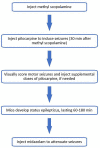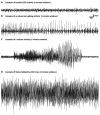Induction of Temporal Lobe Epilepsy in Mice with Pilocarpine
- PMID: 33654757
- PMCID: PMC7842738
- DOI: 10.21769/BioProtoc.3533
Induction of Temporal Lobe Epilepsy in Mice with Pilocarpine
Abstract
In the pilocarpine model of temporal lobe epilepsy (TLE) in rodents, systemic injections of pilocarpine induce continuous, prolonged limbic seizures, a condition termed "Status Epilepticus" (SE). With appropriate doses, many inbred strains of mice show behavioral seizures within an hour after pilocarpine is injected. With the behavioral scoring system based on a modification of the original Racine scale, one can monitor the seizures behaviorally, as they develop into more prolonged seizures and SE. SE is typically associated with damage to subsets of hippocampal neurons and other structural changes in the hippocampus and generally subsides on its own. However, more precise control of the duration of SE is commonly achieved by injecting a benzodiazepine into the mouse 1 to 3 h after the onset of SE to suppress the seizures. Several days following pilocarpine-induced SE, electrographic and behavioral seizures begin to occur spontaneously. The goal of this protocol is to reliably generate mice that develop spontaneous recurrent seizures (SRS) and show the typical neuropathological changes in the brain characteristic of severe human mesial temporal lobe epilepsy (mTLE), without high mortality. To reduce mortality, multiple subthreshold injections of pilocarpine are administered, which increases the percentage of mice developing SE without concomitant mortality. Precise control of the duration of SE (1 or 3 h) is achieved by suppressing SE with the benzodiazepine Midazolam (Versed). We have found that this protocol is an efficient means for generating mice that subsequently develop characteristics of human mTLE including high-frequency interictal spike and wave activity and SRS. In addition, we and others have shown that this protocol produces mice that show excitotoxic cell death of subsets of hippocampal GABAergic interneurons, particularly in the dentate gyrus and compensatory sprouting of excitatory projections from dentate granule cells (mossy fiber sprouting). Aspects of this protocol have been described in several of our previous publications.
Keywords: Epileptogenesis; Hippocampus; Neurodegeneration; Pilocarpine; Seizures.
Copyright © 2020 The Authors; exclusive licensee Bio-protocol LLC.
Conflict of interest statement
Competing interestsThe authors have no competing interests.
Figures






Similar articles
-
Pilocarpine-induced status epilepticus results in mossy fiber sprouting and spontaneous seizures in C57BL/6 and CD-1 mice.Epilepsy Res. 2002 Apr;49(2):109-20. doi: 10.1016/s0920-1211(02)00012-8. Epilepsy Res. 2002. PMID: 12049799
-
Circuit mechanisms of seizures in the pilocarpine model of chronic epilepsy: cell loss and mossy fiber sprouting.Epilepsia. 1993 Nov-Dec;34(6):985-95. doi: 10.1111/j.1528-1157.1993.tb02123.x. Epilepsia. 1993. PMID: 7694849
-
Behavioral and histological assessment of the effect of intermittent feeding in the pilocarpine model of temporal lobe epilepsy.Epilepsy Res. 2009 Sep;86(1):54-65. doi: 10.1016/j.eplepsyres.2009.05.003. Epub 2009 Jun 7. Epilepsy Res. 2009. PMID: 19505798
-
Network and pharmacological mechanisms leading to epileptiform synchronization in the limbic system in vitro.Prog Neurobiol. 2002 Oct;68(3):167-207. doi: 10.1016/s0301-0082(02)00077-1. Prog Neurobiol. 2002. PMID: 12450487 Review.
-
The pilocarpine model of temporal lobe epilepsy.J Neurosci Methods. 2008 Jul 30;172(2):143-57. doi: 10.1016/j.jneumeth.2008.04.019. Epub 2008 Apr 26. J Neurosci Methods. 2008. PMID: 18550176 Free PMC article. Review.
Cited by
-
Mechanisms linking neurological disorders with reproductive endocrine dysfunction: Insights from epilepsy research.Front Neuroendocrinol. 2023 Oct;71:101084. doi: 10.1016/j.yfrne.2023.101084. Epub 2023 Jul 27. Front Neuroendocrinol. 2023. PMID: 37506886 Free PMC article. Review.
-
Pharmacological inhibition of STriatal-Enriched protein tyrosine Phosphatase by TC-2153 reduces hippocampal excitability and seizure propensity.Epilepsia. 2022 May;63(5):1211-1224. doi: 10.1111/epi.17192. Epub 2022 Feb 21. Epilepsia. 2022. PMID: 35188269 Free PMC article.
-
Reprogramming the Circadian Dynamics of Epileptic Genes in Mouse Temporal Lobe Epilepsy.Int J Mol Sci. 2023 Mar 29;24(7):6400. doi: 10.3390/ijms24076400. Int J Mol Sci. 2023. PMID: 37047373 Free PMC article.
-
NLRP3 inflammasome inhibits mitophagy during the progression of temporal lobe epilepsy.Sci Rep. 2025 May 10;15(1):16341. doi: 10.1038/s41598-025-01087-y. Sci Rep. 2025. PMID: 40348802 Free PMC article.
-
Zonisamide nanodiamonds for brain targeting: A comprehensive study utilising in silico, in vitro, in vivo, and molecular investigation for successful nose-to-brain delivery for epilepsy management.Drug Deliv Transl Res. 2025 Jul 5. doi: 10.1007/s13346-025-01904-x. Online ahead of print. Drug Deliv Transl Res. 2025. PMID: 40617996
References
-
- Anderson N. C., Van Zandt M. A., Shrestha S., Lawrence D. B., Gupta J., Chen C. Y., Harrsch F. A., Boyi T., Dundes C. E., Aaron G., Naegele J. R. and Grabel L.(2018). Pluripotent stem cell-derived interneuron progenitors mature and restore memory deficits but do not suppress seizures in the epileptic mouse brain. Stem Cell Res 33: 83-94. - PubMed
-
- Bausch S. B.(2005). Axonal sprouting of GABAergic interneurons in temporal lobe epilepsy. Epilepsy Behav 7: 390-400. - PubMed
-
- Borges K., Gearing M., McDermott D. L., Smith A. B., Almonte A. G., Wainer B. H. and Dingledine R.(2003). Neuronal and glial pathological changes during epileptogenesis in the mouse pilocarpine model. Exp Neurol 182(1): 21-34. - PubMed
Grants and funding
LinkOut - more resources
Full Text Sources
Other Literature Sources

